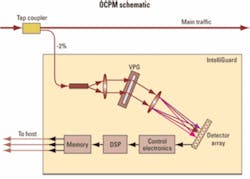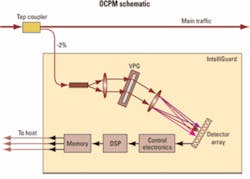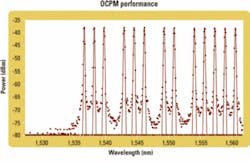Real-time performance monitoring benefits reconfigurable optical networks
By Alex Vukovic, Michel Savoie, Heng Hua, William Yang, and Eric Bergles
Revenue opportunities via next-generation networks are based on the emergence of new services such as video-on-demand (VoD), high-definition television (HDTV), voice over IP (VoIP) for residential applications, and unified multisite connectivity via IP-based virtual private networks (IP-VPNs) for enterprise users. From a network architecture perspective, it appears that a network configuration consisting of reconfigurable optical add/drop multiplexers (ROADMs) is best suited to deploy and deliver these services. Such a network supports a variety of network topologies, accommodates current services (e.g., SONET/SDH, Ethernet, etc.), and is protocol transparent. A ROADM-enabled network also features a standards-based distributed optical control plane (such as Generalized Multi-Protocol Label Switching-GMPLS) for lightwave provisioning, bandwidth allocation, discovery of topology and resources. These features enable a “dynamically reconfigurable network” that offers cost-efficient use of bandwidth.
In such a network, the common control plane (serving the IP and physical layers) allows the coordination of the switched light paths, as well as resource availability and protection optimization. Therefore, it is of critical value to efficiently monitor the physical layer. Additionally, the removal of regenerators and the concurrent increase in the number of amplifiers cascaded along a path add network complexity. Therefore, a physical (optical) layer monitoring scheme, based on monitoring and tracking the key optical parameters of each wavelength, becomes a technology enabler for dynamic and flexible next-generation networks.
However, performance monitoring in the optical domain poses several challenges: the selection of the right optical parameters to monitor; simultaneous, real-time data gathering; and accurate and reliable identification, processing, and transmission of the data to a network management system that will enable service recovery within 50 msec. Long-term network developments (packet switching, 40G+ systems, etc.) push optical performance monitoring requirements even higher.
Communications Research Centre (CRC) in Canada and BaySpec Inc., a developer of performance monitoring technology, recently collaborated to illustrate such a scheme. BaySpec provided an optical channel performance monitor (OCPM) based on proprietary technology, while CRC demonstrated proof-of-concept of network monitoring in an experimental testbed. The collaboration aimed to demonstrate network monitoring (on a per-wavelength basis), OCPMs as cost-effective measuring devices, and the application of these devices in a network testbed.
The wavelength monitoring concept presented in this article can be used to detect, identify, and locate signal degradations in real time. It provides critical inputs for protection switching, line equalization, and span monitoring, and eliminates the need for operators at every site and skilled field technicians. Further development of the concept might enable the construction and control of complex network topologies while efficiently maintaining a high quality of service (QoS) and the fulfillment of service-level agreements (SLAs).
Each wavelength in a reconfigurable network is characterized based on several parameters: channel presence, channel central wavelength position, central wavelength drift with respect to the ITU grid, channel power, channel power distribution, and optical signal-to-noise ratio (OSNR). With real-time information of these parameters, one can detect signal degradation or failure, locate it, and sometimes discover the cause of it. Based on timely information, corrective actions can be taken before failures occur.
The wavelength monitoring and tracking concept in a densely populated reconfigurable network consists of the following:
A network of distributed OCPMs can be used to perform this network monitoring. The OCPM used in the testbed demonstration is essentially an integrated spectrometer, operating in the optical layer, that measures all individual channels in real time (including noninvasive power, OSNR, and central wavelength) and provides rapid channel identification. This device consists of a spectral element, a detection unit, and an electronic processing unit, as illustrated in Figure 1.
The OCPM uses a proprietary high-resolution, volume phase gratings (VPG) spectral dispersion element and a highly sensitive InGaAs array detector as the detection unit to provide both high-speed parallel processing and continuous spectrum measurements. In operation, a fraction of the signal is taken from a main data transmission link using a tap coupler. The tapped signal is quite weak, typically 1% to 2% in magnitude, depending on the application. The light is sent to the one-port OCPM through a singlemode fiber and is collimated by a micro lens. The signal is spectrally dispersed by the VPG. The diffracted field is then focused onto a multielement array detector. The control electronics read out the signal, which is then processed by a DSP to extract the information.It is worth noting that this OCPM responds to a continuous spectral band, rather than to a series of discrete wavelengths. This is a differential advantage over approaches based on tunable filters. More important, as the ambient temperature changes, the center wavelengths of the carrier signal in a DWDM network will offset from the wavelength references. The ability to detect wavelength power and wavelength presence is demonstrated in Figure 2. Both the present and absent wavelengths can be detected.
The wavelength monitoring concept was demonstrated in a metro-network testbed. The testbed featured a ROADM in one node, as shown in Figure 3. The OCPM was combined with a photonics crossconnect element to enable the monitoring of several strategic points throughout the network (M1, M2, and M3 in Figure 3). The OCPM’s role was to provide simultaneous, real-time measurements and observation of channel presence and measure individual channel power (i.e., overall power distribution), OSNR for each channel, and channel center wavelength position of all the wavelengths in the optical domain.
A fraction of the light power (1%) was tapped from the mainstream optical signal for monitoring purposes. The tapped signal was then directed to the spectral element, from which the channelized wavelength components were separated in space. The spatially dispersed signals were detected by a series of detectors, where the optical signals were converted to electrical signals for processing. Supporting software was developed to track the real-time measurements, as shown in Figure 3, with a better than 10-msec response time (example shown involves 32 wavelengths).
Based on the OCPM capability in the testbed and the software developed, the following information was provided: channel presence, channel central wavelengths, central wavelength drift with respect to the ITU grid, channel power and channel power distribution, and OSNR of each channel, as shown on the OCPM graph in Figure 3. There were also thresholds established for each monitored parameter (power, OSNR, and wavelength center position). Upon exceeding the set thresholds, conditions requiring corrective action or immediate attention could be automatically reported to a network operator via e-mail, phone, or pager.
Extending the concept beyond the experimental testbed, information collected by OCPMs from different places in a network could be sent to a network management and control system. Once received, the information could be processed and the control system would be able to make appropriate decisions about the right time to switch the path (protection switching), equalize power between channels, or replace equipment due to aging.The concept is a step toward building a complete wavelength monitoring and tracking system for reconfigurable, densely populated optical networks. Service providers and network operators can simultaneously monitor and track wavelengths in real time and set up the “safe” operating range for any of the key parameters (power, center of wavelength, and OSNR). Additionally, they can change parameters at any time and these changes can be accomplished remotely. Thus, the capabilities inherent in the concept could play a strong role in preventive maintenance and lead toward a reduced need for skilled field technicians to isolate and repair faults.
Monitoring at the physical layer with feedback to a common control plane enables distributed wavelength monitoring across the network, in particular the detection, identification, and localization of faults as well as feedback for protection switching or power balancing. The detection of signal degradation could trigger protection schemes or assist in the diagnosis of a range of issues (e.g., malfunctioning of lasers, amplifiers, or multiplexers). Aside from real-time system error warning and alarming, outputs from the OCPM could be used for amplifier gain balancing or remote gain equalization of DWDM systems, line equalization, or span monitoring.
However, the challenges of wavelength monitoring in reconfigurable optical networks are recognized as well:




